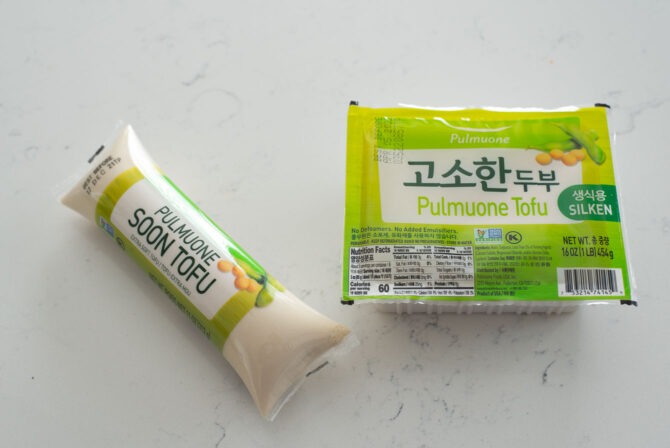Korean Tofu
Tofu is made by coagulating soy milk and pressing the curds into blocks. It’s a common source of plant-based protein. Our body absolve the soy protein more easily from the fofu than from the soy itself.
Tofu originated in China. There are several legends regarding who invented tofu. But tofu has been in Chinese cuisine for two thousand years and it was introduced in Korea during Koryeo dynasty around 13 to 14 century.
Tofu became a staple ingredients in Korean cuisine. Korean tofu (dubu, 두부) is used in many soups (guk, 국), stews (jjigae, 찌개), and side dishes (banchan, 반찬). Check out my Healthy Asian Tofu Recipes for ideas.
Korean tofu is divided into three texture types: Firm, soft, and silken (or extra soft).
Firm Tofu (buchim-yong, 부침용)
Firm tofu has the least amount of moisture and has a spongy firm texture. It is sold in water-filled container to help preserve freshness. Firm tofu is mostly used in stir-fries and pan-fried dishes as you see in my crispy Korean pan-fried tofu, quick braised tofu, and meat tofu patties.
Soft Tofu (jjigae-yong, 찌개용)
Korean soft tofu is similar to the firm tofu, but has more water content and much softer in texture. This tofu is widely used in Korean soups and stews. It retains its soft texture without falling apart even after the long simmering. It also absolve the flavor of stew within the tofu making it more flavorful.
The classic doenjang jjigae (Korean soybean paste stew), kimchi jjigae (kimchi stew) are a great recipes using soft tofu. For other dishes like tofu with egg and tomato, Korean watercress tofu salad, tofu broccoli salad and mapo tofu is another great recipes using soft tofu in the dishes.
Silken tofu (saengsik-yong, 생식용, or yeondubu, 연두부)
Silken tofu is undrained, unpressed tofu that has the highest water content and a custard-like texture. It is often considered as extra-soft tofu.
Silken tofu can be eaten on its own, there for it is often called saengsik-yong (생식용) which translates into “for eating fresh right out of the package without cooking.
Koreans silken tofu comes in two different types of packaging. One in tube, and the other in plastic container. We call it soondubu (in tube) or yeondubu (in container) depending on the type of dish that this tofu is used, but it is all the same silken tofu.
Silken tofu doesn’t hold shape very well on its own, so be extra careful when handling the tofu.
Note: You might get confused when Korean dishes using silken tofu often indicates soft tofu instead of using the term “silken tofu”. For example, Korean soft tofu soup called soondubu jjigae carries its English title “soft tofu” but it is the silken tofu that is used in the actual recipe. For some reason, this has been a common practice that soft tofu has been used in the dish name when it is translated into English.
The most well known dish made with silken tofu in Korean cuisine is the iconic Korean soft tofu soup called soondubu jjigae.
Other recipes that I recommend trying with silken tofu is quick soft tofu recipe served with Korean soy chili sauce, oyster soft tofu rice bowl, tofu and egg pudding in a microwave.














